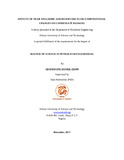| dc.description.abstract | Gas condensate reservoirs are initially discovered as single-phase gas reservoirs. As the reservoir is produced below the fluid dew-point pressure, an increase in condensate saturation in the near wellbore region occur which reduces the relative permeability to gas and in turn causes productivity impairment. It is pertinent to predict condensate banking behavior accurately during a field’s operational phase to avoid problems with a well’s ability to attain production targets. This paper seeks to explore the effects of near wellbore and reservoir fluid compositional changes on condensate banking using Velocity Dependent Relative Permeability (VDRP). To achieve this, a PVT data for gas condensate reservoir from a field was used to build an input data file using Eclipse 300. A single-layer, radial, 3D reservoir model was used to investigate the effects of VDRP on productivity index, relative permeability to gas and condensate recovery. A fully perforated vertical well was located at the center of the reservoir model. The reservoir model consisted of 30 grid blocks increasing logarithmically with radius away from the wellbore. The use of fine-resolution gridding near the wellbore was to ensure that change in condensate was accurately simulated. When Velocity Dependent Relative Permeability (VDRP) option was adopted for volume flow rate of 10Mscfpd, there was no change in the gas relative permeability and productivity index. This was due to low flow rate. However, when the flow rate was increased to 1000Mscfpd and 2000Mscfpd, the gas relative permeability reduced only by 36.1% and 23.6% respectively while the Productivity Index reduced by 34.2% and 21.7% respectively. The positive effect of VDRP assisted these low values.
In contrast, for situations where VDRP does not apply, the effects of condensate banking were significant. That is, neglecting the VDRP option under the same flow rates, a reduction in the gas relative permeability and the Productivity Index was observed to be approximately 72%. Adopting VDRP does not improve the condensate recovery as expected probably due to large uncertainty in VDRP parameters due to lack of core experimental data. These results suggest that the most detrimental effect of condensate banking is caused by neglecting VDRP. It is intended that the findings of this study be used to screen for potential condensate banking in later life of wells in gas condensate reservoirs. | en_US |

